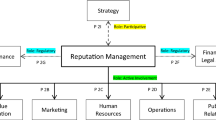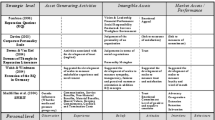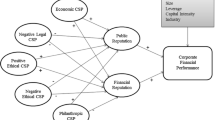Abstract
In this paper, we identify two important approaches to corporation reputation building: symbolic management and behavioral management. Within the first approach, corporate communications are intended to generate positive impressions among ‘media audiences’. Within the second approach, corporate actions are changed to more closely align with the message being conveyed by corporation communications. Many corporate managers assume that the symbolic alignment between what is wanted by media audiences and what is said enhances corporate reputation and this, in turn, improves corporate profitability. In this paper, we tested the relative efficacy of the symbolic and behavioral management approaches to corporate reputation and profitability. We found that symbolic management had a positive effect on symbolic reputation, whereas behavioral management had a positive effect on performance reputation. We also found that a positive reputation in the media did not contribute to corporate profitability, whereas a positive performance reputation had a significant effect on profitability. We conclude that the behavioral management approach is more effective for reputation building and for contributing to profitability. We also discuss implications of our findings for reputation management and corporate performance.






Similar content being viewed by others
Notes
From The Arab British Business Bulletin, 2005, Vol. 28, Issue 40.
While symbolic and behavioral management approaches in reputation-building are concepts developed from the public relations literature, they are similar to symbolic and substantive management concepts in organization studies (Ashforth and Gibbs, 1990; Pfeffer, 1981).
Social scientists have some fear or ‘prejudice’ against posing and testing null hypotheses (Cortina and Folger, 1998: 335). Greenwald (1993) called such fear and prejudice a ‘cultural truism’ and he ‘dismantled’ opinions against testing the null hypothesis. In defending the practice of posing and testing null hypotheses, Cortina and Folger (1998) further explained that null hypothesis testing is appropriate when (1) ‘predicting a null effect as a derivation from theory’ in advance – ie, a priori hypothesis derivation and (2) establishing boundary conditions for known effects – ie, design and test when significant effect can be found. In our study, we met the two essential conditions for null hypothesis testing. First, we postulate in advance a priori hypotheses regarding the ineffective paths from symbolic management to financial performance. In addition, we proposed and tested significant alternative hypotheses (ie, known effects) regarding the paths in behavioral management approach against the null hypotheses in the same testing model. Thus, we consider our null hypothesis testing approach justifiable.
References
Ashforth, B.E. and Gibbs, B.W. (1990) ‘The double-edge of organizational legitimation’, Organization Science, 1 (2), 177–194.
Bansal, P. and Clelland, I. (2004) ‘Talking trash: Legitimacy, impression management, and unsystematic risk in the context of the natural environment’, Academy of Management Journal, 47 (1), 93–103.
Bentler, P.M. (2004)EQS 6 6 Structural Equation Program Manual, Multivariate, Software Inc., Encino, CA.
Bollen, K.A. (1989)Structural Equations with Latent Variables, John Wiley & Sons, New York, NY.
Brady, A. (2005) ‘The sustainability effect: New business paradigm for the Middle East’, Arab British Business Bulletin, 28 (40), 24–25.
Bromley, D. (2002) ‘Comparing corporate reputations: League tables, quotients, benchmarks, or case studies?’Corporate Reputation Review, 5 (1), 35–50.
Brown, B. and Perry, S. (1994) ‘Removing the financial performance halo from fortune’s ‘Most Admired’ Companies', Academy of Management Journal, 37, 1347–1359.
Byrne, B.M. (1994) Structural Equation Modeling with EQS and EQS/Window: Basic Concepts, Applications, and Programming';, Sage, Thousand Oaks, CA.
Christmann, P. (2000) ‘Effects of best practices of environmental management on cost advantage: The role of complementary assets’, Academy of Management Journal, 43, 663–680.
Cortina, J.M. and Folger, R.G. (1998) ‘When is it acceptable to accept a null hypothesis: No way, Jose?’Organizational Research Methods, 1, 334–350.
Davis, G., Kincaid, L., Swanson, M., Schultz, T., Bartmess, J., Griffith, B. and Jones, S. (1994) Chemical Hazard Evaluation for Management Strategies: A Method for Ranking and Scoring Chemicals by Potential Human Health and Environmental Impact, Office of Research and Development, EPA/600/R-94/177, U.S. EPA, Washington, DC.
Deephouse, D.L. (2000) ‘Media reputation as a strategic resource: An integration of mass communication and resource-based theories’, Journal of Management, 26 (6), 1091–1112.
Fombrun, C.J. (1996) Reputation: Realizing Value from the Corporate Image, Harvard Business School Press, Massachussets.
Fombrun, C.J. (2005) ‘A world of reputation research, analysis, and thinking: Building corporate reputation through CSR initiatives: Evolving standards’, Corporate Reputation Review, 8 (1), 7–11.
Fombrun, C.J. and Shanley, M. (1990) ‘What's in a Name? Reputation Building and Corporate Strategy’, Academy of Management Journal, 33, 233–258.
Fryxell, G.E. and Wang, J. (1994) ‘The fortune corporate ‘reputation: Index: reputation for what?’Journal of Management, 20, 1–14.
Gilley, K.M., Worrell, D.L. and El-Jelly, A. (2000) ‘Corporate environmental initiatives and anticipated firm performance: The differential effects of process-driven versus product-driven greening initiatives’, Journal of Management, 26 (6), 1199–1216.
Greenwald, A.G. (1993) ‘Consequences of prejudice against the null hypothesis’, in G. Keren & C. Lewis (eds.)A Handbook for Data Analysis in Behavioral Sciences, Lawrence Erlbaum, Hillsdale, NJ.
Grunig, J.E. (1992) ‘What is excellence in management?’, in J.E. Grunig (ed.)Excellence in Public Relations and Communication Management, Lawrence Erlbaum Associates, Hillsdale, NJ.
Grunig, J.E. (1993) ‘Image and substance: From symbolic to behavioral relationships’, Public Relations Review, 19, 121–139.
Grunig, J.E. (2003) ‘Constructing public relations theory and practice’, in B. Dervin and S.H. Chaffee (eds.)Communication, a Different Kind of Horserace, Hampton Press, Cresskill, NJ.
Grunig, J.E. (2006) After 50 Years: The Value and Values of Public Relations, Speech Delivered to The Institute for Public Relations 45th Annual Distinguished Lecture, The Yale Club, New York, 9 November, 2006.
Grunig, J.E. and Grunig, L.A. (1998) ‘The relationship between public relations and marketing in excellent organizations: evidence from the IABC study’, Journal of Marketing Communications, 4, 141–162.
Grunig, J.E. and Hunt, T. (1984) Managing Public Relations, Holt, Rinehart and Winston, New York, NY.
Grunig, L.A., Grunig, J.E. and Dozier, D.M. (2002) Excellent Public Relations and Effective Organizations: A Study of Communication Management in Three Countries, Lawrence Erlbaum, Mahwah, NJ.
Hamilton, J.T. (1995) ‘Pollution as news: Media and stock market reactions to the toxics release inventory data’, Journal of Environmental Economics and Management, 28, 98–113.
Hammond, S.A. and Slocum Jr, J.W. (1996) ‘The impact of prior firm financial performance on subsequent corporate reputation’, Journal of Business Ethics, 15, 159–165.
Hart, S. and Ahuja, G. (1996) ‘Does it pay to be green? An empirical examination of the relationship between emission reduction and firm performance’, Business Strategy and the Environment, 5, 30–37.
Hu, L. and Bentler, P.M. (1999) ‘Cutoff criteria for fit indexes in covariances structure analysis: Conventional criteria versus new alternatives’, Structural Equation Modeling, 6, 1–55.
Kim, Y. (2001) ‘Measuring the economic value of public relations’, Journal of Public Relations Research, 13 (1), 3–26.
Klassen, R. and McLaughlin, C.P. (1996) ‘The impact of environmental management on firm performance’, Management Science, 42 (8), 1199–1213.
MacKinnon, D.P., Lockwood, C.M., Hoffman, J.M., West, S.G. and Sheets, V. (2002) ‘A comparison of methods to test mediation and other intervening variable effects’, Psychological Methods, 7, 83–104.
McGuire, J.B., Schneeweis, T. and Branch, B. (1990) ‘Perceptions of firm quality: A cause or result of firm performance’, Journal of Management, 16, 167–180.
McWilliams, A., Van Fleet, D.D. and Cory, K.D. (2002) ‘Raising rivals costs through political strategy: An extension of resource-based theory’, Journal of Management Studies, 39 (5), 707–723.
Miles, M.P. and Covin, J.G. (2000) ‘Environmental marketing: A source of reputational, competitive, and financial advantage’, Journal of Business Ethics, 23, 299–311.
Nehrt, C. (1996) ‘Timing and intensity effects of environmental investments’, Strategic Management Journal, 17 (7), 535–547.
Office of Pollution Prevention Toxics (1995) 1993 Toxics Release Inventory: Public Data Release', EPA 745-R-95-010Environmental Protection Agency, Washington, DC.
Pfeffer, J. (1981) ‘Management as symbolic action: The creation and maintenance of organizational paradigms’, in L.L. Cummings and B.M. Staw (eds.)Research in organization behavior, Vol. 3,JAI Press, Greenwich, CT.
Post, J.E., Preston, L.E. and Sachs, S. (2002) Redefining the Corporation: Stakeholder Management and Organizational Wealth, Stanford University Press, Stanford, CA.
Rindova, V.P., Williamson, I.O., Petkova, A.P. and Sever, J.M. (2005) ‘Being good or being known: An empirical examination of the dimensions, antecedents, and consequences of organizational reputation’, Academy of Management Journal, 48, 1033–1049.
Roberts, P.W. and Dowling, G.R. (2002) ‘Corporate reputation and sustained superior financial performance’, Strategic Management Journal, 23, 1077–1093.
Salama, A.I. (2003) A Median Regression Analysis of the Relationship between Environmental Reputation and Corporate Financial Performance: Empirical Evidence on UK firms, A paper presented at the Rensselaer Polytechnic Institute Conference, October, New York.
Shamsie, J. (2003) ‘The context of dominance: An industry-driven framework for exploiting reputation’, Strategic Management Journal, 24 (3), 199–215.
Sobel, M.E. (1982) ‘Asymptotic intervals for indirect effects in structural equations models’, in S. Leinhart (ed)Sociological Methodology 1982, Jossey-Bass, San Francisco.
TRI Program Division (2005) 2003 TRI Public Data Release eReport, US Environmental Protection Agency, Retrieved June 2, 2005, from http://www.epa.gov/tri/tridata/tri03/2003eReport.pdf.
Wood, D.J. (1991) ‘Corporate social performance revisited’, Academy of Management Review, 16 (4), 691–718.
Acknowledgements
We would like to thank Pratima Bansal (University of Western Ontario) for her important assistance with measure construction and helpful comments on our conceptual development.
Author information
Authors and Affiliations
Rights and permissions
About this article
Cite this article
Kim, JN., Bach, S. & Clelland, I. Symbolic or Behavioral Management? Corporate Reputation in High-Emission Industries. Corp Reputation Rev 10, 77–98 (2007). https://doi.org/10.1057/palgrave.crr.1550042
Published:
Issue Date:
DOI: https://doi.org/10.1057/palgrave.crr.1550042




